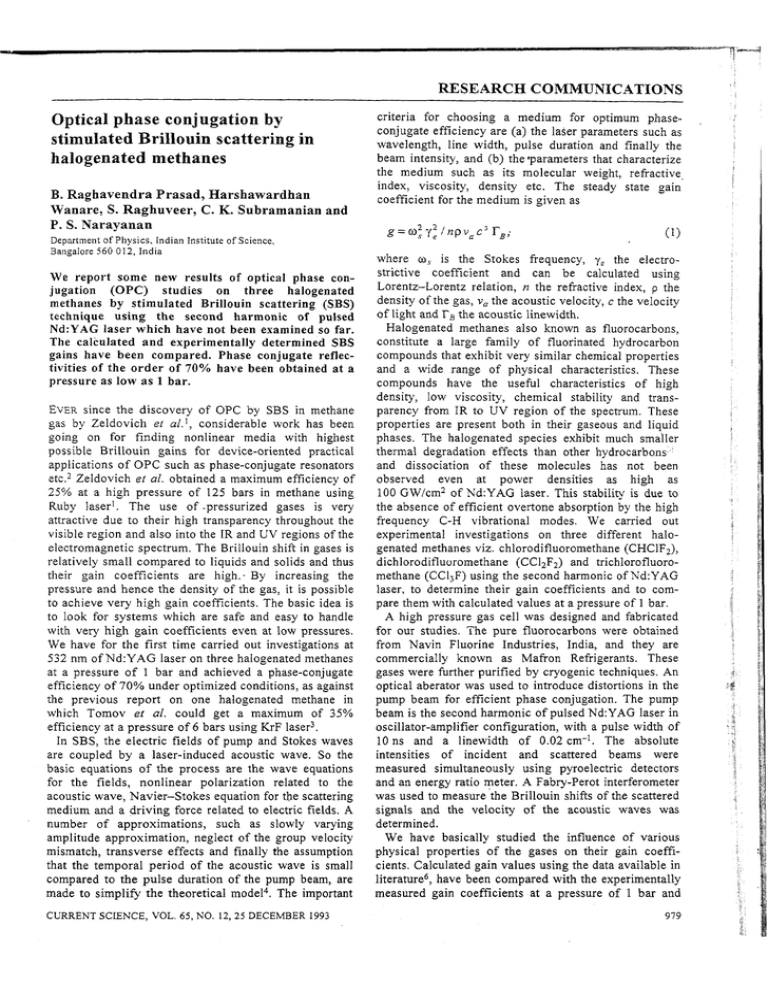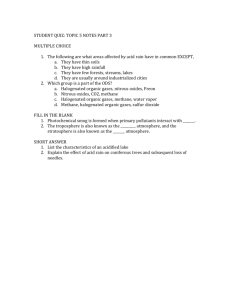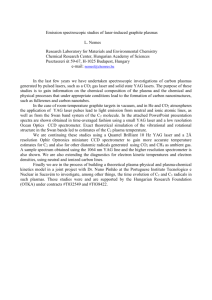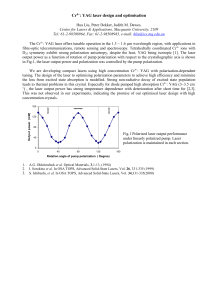in Optical phase conjugation by stimulated Brillouin scattering halogenated methanes
advertisement

RESEARCH COMMUNICATIONS Optical phase conjugation by stimulated Brillouin scattering in halogenated methanes B. R a g h a v e n d r a Prasad, H a r s h a w a r d h a n W a n a r e , S. R a g h u v e e r , C. K. S u b r a m a n i a n a n d P. S. N a r a y a n a n Department of Physics, Indian Institute of Science, Bangalore 560 0 12, India We report some new results of optical phase conjugation (OPC) studies on three halogenated methanes by stimulated Brillouin scattering (SBS) technique using the second harmonic of pulsed Nd:YAG laser which have not been examined so far. The calculated a n d experimentally determined SBS gains have been compared. Phase conjugate reflectivities of the o r d e r of 70% have been obtained a t a pressure as Iow a s 1 bar. EVERsince the discovery of OPC by SBS in methane gas by Zeldovich et al.', considerable work has been going on for finding nonlinear media with highest possible Brillouin gains for device-oriented practical applications of OPC such as phase-conjugate resonators etc.* Zeldovich et al. obtained a maximum efficiency of 25% at a high pressure of 125 bars in methane using Ruby laser1. The use of -pressurized gases is very attractive due to their high transparency throughout the visible region and also into the IR and UV regions of the electromagnetic spectrum. The Brillouin shift in gases is relatively small compared to liquids and solids and thus their gain coefficients are high: By increasing the pressure and hence the density of the gas, it is possible to achieve very high gain coefficients. The basic idea is to look for systems which are safe and easy to handle with very high gain coefficients even at low pressures. We have for the first time carried out investigations at 532 nm of Nd:YAG laser on three halogenated methanes at a pressure of 1 bar and achieved a phase-conjugate efficiency of 70% under optimized conditions, as against the previous report on one halogenated methane in which Tomov et al. could get a maximum of 35% efficiency at a pressure of 6 bars using KrF laser3. In SBS, the electric fields of pump and Stokes waves are coupled by a laser-induced acoustic wave. So the basic equations of the process are the wave equations for the fields, nonlinear polarization related to the acoustic wave, Navier-Stokes equation for the scattering medium and a driving force related to electric fields. A number of approximations, such as slowly varying amplitude approximation, neglect of the group velocity mismatch, transverse effects and finally the assumption that the temporal period of the acoustic wave is small compared to the pulse duration of the pump beam, are made to simplify the theoretical model4. The important CURRENT SCIENCE, VOL. 65, NO. 12,25 DECEMBER 1993 criteria for choosing a medium for optimum phaseconjugate efficiency are (a) the laser parameters such as wavelength, line width, pulse duration and finally the beam intensity, and (b) theeparameters that characterize the medium such as its molecular weight, refractive index, viscosity, density etc. The steady state gain coefficient for the medium is given as where o , is the Stokes frequency, y, the electrostrictive coefficient and can be calculated using Lorentz-Lorentz relation, n the refractive index, p the density of the gas, v, the acoustic velocity, c the velocity of light and rBthe acoustic linewidth. Halogenated methanes also known as fluorocarbons, constitute a large family of fluorinated hydrocarbon compounds that exhibit very similar chemical properties and a wide range of physical characteristics. These compounds have the useful characteristics of high density, low viscosity, chemical stability and transparency from IR to UV region of the spectrum. These properties are present both in their gaseous and liquid phases. The halogenated species exhibit much smaller thermal degradation effects than other hydrocarbons and dissociation of these molecules has not been observed even at power densities as high as 100 GW/cm2 of Nd:YAG laser. This stability is due to the absence of efficient overtone absorption by the high frequency C-H vibrational modes. We carried out experimental investigations on three different halogenated methanes viz. chlorodifluoromethane (CHCIF2), dichlorodifluoromethane (CC12F2) and trichlorofluoromethane (CC13F) using the second harmonic of Nd:YAG laser, to determine their gain coefficients and to compare them with calculated values at a pressure of 1 bar. A high pressure gas cell was designed and fabricated for our studies, The pure fluorocarbons were obtained from Navin Fluorine Industries, India, and they are commercially known as Mafron Refrigerants. These gases were further purified by cryogenic techniques. An optical aberator was used to introduce distortions in the pump beam for efficient phase conjugation. The pump beam is the second harmonic of pulsed Nd:YAG laser in oscillator-amplifier configuration, with a pulse width of 10 ns and a linewidth of 0.02 cm-'. The absolute intensities of incident and scattered beams were measured simultaneously using pyroelectric detectors and an energy ratio meter. A Fabry-Perot interferometer was used to measure the Brillouin shifts of the scattered signals and the velocity of the acoustic waves was determined. We have basically studied the influence of various physical properties of the gases on their gain coefficients. Calculated gain values using the data available in literature6, have been compared with the experimentally measured gain coefficients at a pressure of 1 bar and RESEARCH COMMUNICATIONS gases and found that the reflectivity increases with intensity and it does not saturate as can be seen in Figure 1. In conclusion, the three halogenated methanes studied for the first time for their phase conjugate efficiencies are highly efficient systems even at a very low nressure of the order of 1 bar. Detailed investigations on these gases are in progress. Pressure = 1 Bar 100 200 300 P u m p intensity ( m J) i 400 Figure 1. Intensity dependence of PC reflectivity for all gases at P = l bar. they were found to agree well. We have also studied the intensity dependence of OPC reflectivity for all the three Crystal structure of L-phenylalanyl-glycine: trichloroacetate and its relevance to the bioactive conformation of the enkephalins S h o m e N a t h Mitra and E. S u b r a m a n i a n Department of Crystallography and Biophysics, University of Madras, Guindy Campus, Madras 600 025, India A dipeptide L-phenylalanyl-glycine has been crystallized as a 1 : l complex with trichloroacetic acid. T h e crystal structure has been' determined using direct methods a n d refined to a final R-index of 0.059 for 1203 reflections (with sin BIAS 0.60 A-1 and 1 2 3 0 (I)).The trans-peptide unit shows significant deviation from planarity. T h e peptide backbone is folded with torsion angles a t glycine adopting a Dresidue conformation. Relevance of the study to bioactive conformation of enkephalins is discussed. '" '?as been reported that enkephalins tyr-gly-gly'"'1 (met) show enhanced activity if the second sequence, namely, glycine is substituted 7 acid residue. Such a substitution would :he torsion angle @ for this residue to ++ 1. Zeldovich, B Ya., Popovichev, V. I., Ragul'skii, V. V. and Faizullov, F. S., JETP Lett., 1972, 15, 109. 2. Rockwell, D. A., IEEE J. Quantum Electron., 1988, QE-24, 1124-1 140. 3. Tomov, I. V., Fedosejevs, R. and McKen, D C. D., IEEE .J. Quantum Electron., 1985, QE-21, 9-1 14. 4. Kaiser, W. and Maier, M., Laser Handbook (eds Arecchi, F. T, and Schulz-Dubois, E. O.), North-Holland, Amsterdam, 1972, VOI.2, pp. 1077-1 150. 5. Damzen, M. J., Hutchinson, M . 14. R, and Schroder, W. A,, IEEE J. Quantum Electron., 1987, QE-23, 328-334. 6. Braker, W. and Mossman, A. L., hatheson Gas Data Book, 6t11 edn., NJ, USA, 1980. ACKNOWLEDGEMENT. This work was supported by the Defence Research and Development Orpanisation, Ministry of Defence, Government of India, and our sincere thanks are due to them. Received 7 August 1993; revised accepted 29 September 1993 Table 1. Crystal data For L-phenylalanyl-glycine:trichloroaceticacid solvate Molecular formula Molecular weight Crystal system Unit cell dimensions Volume Space group Number of n~oleculesper cell Density calculated Radiation used P (CuK,) Temperature Scan mode Crystal size Unique reflections measured Number of reflections wlth / 2 3 u (4 Absorption correction Maximum sin 611 R R, : C, ,1-1,4N20j. CC13 COOI-1 : 385.6 : Monoclinic : a = 1 l.3lO(2) A b = 6.3 12(2) c = 1 l.912(1) p = 95.86(1)' : 845.9(7) A" : P2, :2 : 1.514 ~ g m - " : CuKa ( h = 1.5418 A) : 52.46 cm-I : 25°C : wR6 : 0.20 x 0.30 x 0.70 mm : 1318 : 1203 Empirical : 0.60 A-' : 0.059 : 0.073 assume positive @ values in the Ramachandran plot. The implication is that the peptide unit (involving amide and carbonyl groups) for this residue in the enkephalins presumably has to adopt a well-defined orientation CURRENT SCIENCE, VOL. 65, NO. 1 2 , 2 5 DECEMBER 1993






